William Raborn And The New Manhattan Chemtrail Project
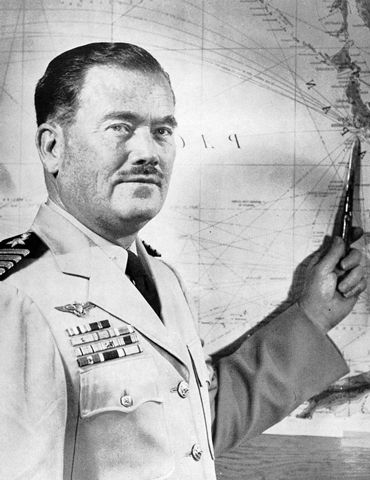
William Francis Raborn, Jr.
Navy Vice Admiral William Francis Raborn, Jr. (1905-1990) appears to have been central to the development of today’s global weather modification project entitled by some the New Manhattan Project. He was deeply involved in the development of the Project’s defining element, electromagnetic energy. As we will see, Raborn may have also came up with the plan used for the New Manhattan Project’s continuing organization and development. Raborn appears to have been a most important administrator to the biggest scientific effort in Human history. This article tells his story.
Vice Admiral Raborn authored a 1963 article titled “New Horizons of Naval Research and Development” in which he writes about powerful atmospheric control achieved by the use of electromagnetic energy. Raborn was on the board of directors of a company called LTV Electrosystems and the later E-Systems which built the first iteration of the world’s most powerful and versatile ionospheric heater, the High-frequency Active Auroral Research Program (HAARP). This is significant because ionospheric heaters are known to be able to modify the weather with electromagnetic energy. His later position as director of the CIA also warrants investigation here because the CIA has many connections to the New Manhattan Project (NMP). But prior to all that, Vice Admiral Raborn’s introduction to all things New Manhattan Project began with his submarine-launched ballistic missile (SLBM) program called ‘Polaris.’
Polaris
In the mid-1950s, under their Special Projects Office, the United States Navy began developing a nuclear powered submarine capable of launching a ballistic (i.e. thermonuclear) missile while submerged. These efforts went by many different names and stages of development early on, but the effort that was ultimately successful was called Polaris. Early in this development, then Rear Admiral William Raborn took command. Before this assignment, Raborn had distinguished himself in the development of small, tactical, air-launched missiles.
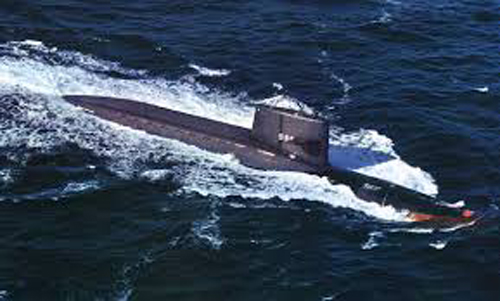
Polaris submarine
The eponymous Polaris missile was developed by former Nazi scientists at the Army’s Redstone Arsenal outside of Huntsville, Alabama, at Lockheed in Sunnyvale, CA, and at Aerojet-General facilities near Sacramento, CA. These Nazi scientists were brought to America as part of Operation Paperclip. In 1942 it was Nazi scientists, including the most famous Wernher von Braun (1912-1977), who first successfully launched a missile from a submerged submarine. The Polaris missile’s development can be traced back to the Nazi V1 rocket which terrorized Britain and the rest of Europe during WWII. Raborn was later to become vice president for program-management at Aerojet-General.
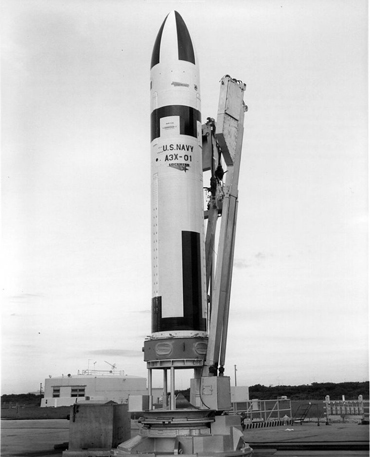
Polaris missile
Along these lines, it was Hughes Electronics which produced a powerful computer for the Polaris submarines. This is significant because Hughes has many connections to the development of the New Manhattan Project and appears to have been thoroughly infested with former Nazi scientists. In 1997 Hughes Electronics was acquired by Raytheon.
The guidance system of the Polaris missile was developed by Raytheon and the Massachusetts Institute of Technology (MIT). This is significant because both Raytheon and MIT have been central to the development of New Manhattan Project technologies. Raborn probably had plenty of opportunities to acquaint himself with people involved in these developments.
It doesn’t end there. Edward Teller and Lawrence Livermore Laboratories (LLNL) developed the Polaris thermonuclear warhead. The development of the Polaris warhead was instrumental to the early growth of LLNL. This is significant because evidence suggests that Edward Teller was the single most important scientist in the history of the New Manhattan Project (NMP) and Lawrence Livermore Labs (which Teller co-founded and directed) is probably today’s New Manhattan Project main command and control center.
Oh, and by the way, General Electric not only developed the first nuclear powered submarines, they also worked on the Polaris fire control and guidance systems. Yes, that General Electric which started the modern era of scientific weather control way back in 1946. As we can see, Raborn was running with the people that brought us the New Manhattan Project.
On November 15, 1960 the first SLBM nuclear submarine produced by the Polaris project, the U.S.S. George Washington made its maiden voyage. Many more came shortly afterwards. The Polaris project was a resounding success. In March, 1962 William Raborn became Deputy Chief of Naval Operations (Development); the head of naval research.
A Formal Introduction at Clam Lake?
Before the advent of nuclear powered submarines such as those produced by the Polaris project, submarines powered by oil combustion needed to stay partially submerged or relatively near the surface because internal oxygen supplies needed for propulsion and human respiration became depleted quickly. Submarines powered by nuclear reactors were suddenly able to dive to depths previously unheard of and stay submerged for extended periods of time because nuclear reactions do not require oxygen. These submarines could dive deep, quickly becoming invulnerable, then spirit away unseen.
But at the time of the first nuclear subs (Polaris had a couple of predecessors), the military had no way of communicating with a deeply submerged submarine. Submarines at or near the surface used similar communications systems as the ships of their day. But standard radio systems did not penetrate significant aquatic depths. The military needed to devise a way to communicate with far-away, deeply submerged submarines. Enter the facilities at Clam Lake and the development of the electromagnetic portions of the New Manhattan Project. It was at these facilities at Clam Lake, straddling the state line with Wisconsin and Michigan, where a way to communicate with deeply submerged submarines thousands of miles away was developed. It was at Clam Lake where Raborn was probably formally introduced to the New Manhattan Project.
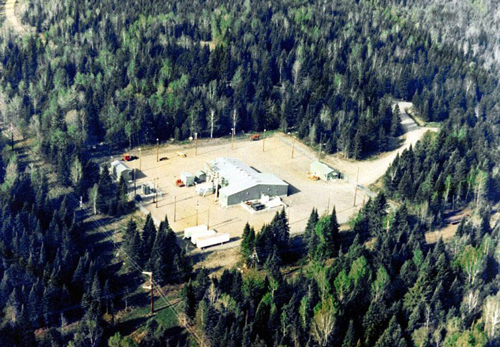
Clam Lake facilities
Beginning in 1958 a series of projects were planned to establish that a deeply submerged submarine thousands of miles away may be sent messages with electromagnetic pulses. These electromagnetic pulses were eventually generated by Clam Lake’s enormous grid of cables 28 miles long strung across the tops of telephone pole-like poles and buried 3 to 6 feet beneath the ground covering 4,000 square miles. The pulses generated by these wires were bounced off the ionosphere and received by deeply submerged nuclear submarines. As the submerged submarines had no way to respond, this was a one-way communications system. The submariners could respond when they eventually surfaced, then using standard communications systems.
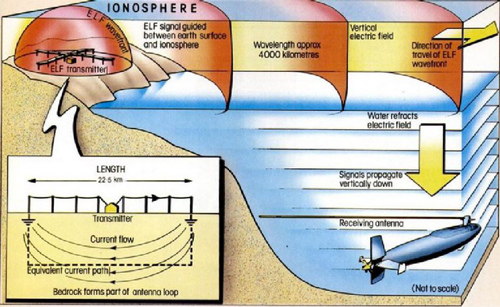
Deeply submerged submarine communications
The facilities at Clam Lake were a link in the chain of the development of ionospheric heaters which are the distinguishing element of today’s New Manhattan Project. The use of electromagnetic energy distinguishes the New Manhattan Project from the traditional cloud seeding industry and has always served as the NMP’s common thread. The facilities at Clam Lake were the immediate precursors of today’s ionospheric heaters. Isn’t it logical then, that the facilities at Clam Lake might also have been used in classified weather modification experiments? Ionospheric heaters are known to be able to modify the weather as well as communicate with submerged submarines. Although classified projects are known to have existed at Clam Lake, the only information that has been declassified concerns submarine communications.
Raborn has a direct connection to Clam Lake. In late 1959 a company called Continental Electronics Manufacturing Company won the $50 million Navy contract to build the facilities at Clam Lake, beating out RCA. Earlier in that year the founder of Continental Electronics Manufacturing Company, a man named James O. Weldon, his wife, and another shareholder had sold Continental Electronics Manufacturing Company to a division of Ling-Temco-Vought called Ling-Altec for around $3.5M. James O. Weldon came along to run it. Weldon would later become chairman of the board of the aforementioned LTV (Ling-Temco-Vought) Electrosystems. Essentially, Ling-Temco-Vought was just a giant corporation, one division of which was LTV Electrosystems. As noted earlier, Raborn was on the LTV Electrosystems Board of Directors. We will have yet more about LTV Electrosystems in the next section.
Clam Lake contract winner Continental Electronics Manufacturing Company was a pioneer in the design and installation of extremely powerful radio transmitters for such customers as the CIA’s Voice of America. The CIA has plenty of ties to the New Manhattan Project. We’ll have a little more about them shortly.
It is also interesting to note that in the same year plans were being drawn up for Clam Lake, an early ionospheric heater was also getting off the ground. In 1958 Professor William Gordon of Cornell University proposed to the Advanced Research Projects Agency (ARPA) that they support the construction of the Arecibo ionospheric heater in Puerto Rico.
LTV Electrosystems / E-Systems / HAARP
The history of LTV Electrosystems is told in the book Ling: The Rise, Fall, and Return of a Texas Titan by Stanley H. Brown. From the mid-1960s to the early 1970s, LTV Electrosystems contracted for the United States Air Force in the repair, overhaul, and modification of aircraft working out of a facility at the former Donaldson Air Force Base in Greenville, South Carolina. As noted earlier, LTV Electrosystems was a division of the defense contractor Ling-Temco-Vought.
Brown writes that for the most part, LTV Electrosystems used to be called Temco. Temco was started after World War II by a Scottish immigrant named Robert McCulloch, an aircraft production man of some repute. Temco was short for Texas Engineering & Manufacturing Company, founded in Dallas. Temco made aircraft, aircraft parts, aircraft sub-assemblies, missiles, and electronic systems for our military.
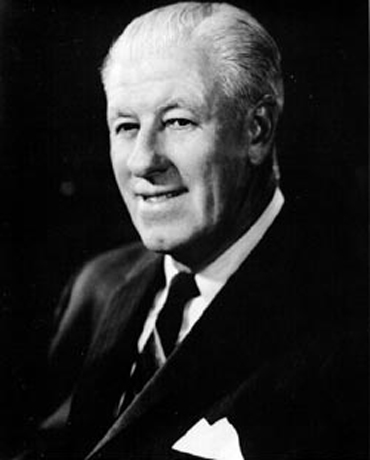
Robert McCulloch
It is interesting to note the involvement here of a man named David Harold Byrd. David Harold Byrd was a major investor first with Robert McCulloch and Temco, then later with Ling-Temco-Vought and James Ling, the founder of LTV. Byrd is interesting for the curious singular fact that he was the owner of the book depository building from which Oswald supposedly assassinated President Kennedy.
During the mid-1960s, LTV Electrosystems was cobbled together from some internal Ling-Temco-Vought sources including Temco, the aforementioned Ling-Altec, and the aforementioned Continental Electronics Manufacturing Company and then spun-off from Ling-Temco-Vought. LTV Electrosystems became its own company with its own public stock traded on a major exchange. But it was still under Ling-Temco-Vought’s wing.
In 1970, Vice Admiral Raborn came to be on the board of directors of LTV Electrosystems. In 1972 LTV Electrosystems was bought and taken private by investors including a man named John W. Dixon. The company changed its name to E-Systems. Raborn stayed on the board. E-Systems went on to complete the first version of the aforementioned HAARP in 1995.
The CIA and “Restoring the Quality of Our Environment”
On April 22, 1965 Vice Admiral Raborn became the Director of the Central Intelligence Agency (CIA). This was to be a short-lived directorship. By all accounts, Raborn was oblivious in the role. He was in over his head. Stories of his inadequacy at the post are legion. 14 months later he resigned.
It is interesting to note that in November of 1965, during Raborn’s CIA directorship, LBJ’s Environmental Pollution Panel of the President’s Science Advisory Committee issued the landmark document titled “Restoring the Quality of Our Environment.” “Restoring the Quality of Our Environment” was the first top level U.S. Government document to state the theory of man-made global warming.
The authors also theorized about all the bad stuff that could happen if the Earth’s average temperature were to fluctuate by two degrees Fahrenheit. Not only did the authors of “Restoring the Quality of Our Environment” provide us with the problem, they also provided us with the solution of small particles in the atmosphere reflecting sunlight back into space, thus cooling the Earth and saving us from the problem of global warming. Way back in 1965 “Restoring the Quality of Our Environment” advocated for the SRM geoengineering thesis which is code for today’s New Manhattan Project.
Although the CIA does not take credit for “Restoring the Quality of Our Environment,” they have produced lots of similar material. In light of this information, doesn’t it make sense then, that the CIA was involved in the production of “Restoring the Quality of Our Environment?”
After leaving the CIA, Raborn returned to Aerojet-General in the Washington D.C. office for three years, then served as president of his own D.C. consulting firm W.F. Raborn Co. Inc. until retiring in 1986. William Francis Raborn died in 1990.
PERT
During the previously outlined Polaris submarine development, in early 1958 at the urging of his administrative assistant Gordon Pehrson, Raborn initiated a special study of potentially powerful new administrative techniques. The study group included representatives of the Special Projects Office, Lockheed, and the consulting firm Booz, Allen, and Hamilton. Ideas put forth by Pehrson formed the basis of the system that was worked out over the next six months. Raborn’s study group came up with something called the Program Evaluation Review Technique (PERT).
The book Polaris! by Baar and Howard describes how, as part of PERT, computers were used to aid the administrative process. It reads:
“The steps needed to develop each part of the Polaris system were put on huge blueprints 15 to 20 feet long. The blueprints were translated into numbers and fed into computers. The computers swiftly told Raborn when each job would be finished, and he could act on this information.
Change a step. Lose a day. Lose an hour. Gain a week. Invent a new kind of anything. The new information was fed into the computers. The computers gave Raborn a revised estimate.ˮ
The book The Secret War for the Ocean Depths by Thomas Burns describes how complex charting was also part of the PERT. It reads:
“The top layer of the chart covered the entire system. The next layer was subdivided into 5 charts, one for each major component of the system. The next layer had 50 charts, and the next layer 100 – each in the same format, each detailing a single activity or project and each tracing a direct relationship to the achievement cycle and timing of the overall program. Each of the charts showed all of the steps required to track a particular job and a timetable based on them. The charts showed who was responsible for seeing that each step was completed. Vertical black lines on the graph showed how the timing coincided with the flow of project activity. Colored markers were placed beside the steps to indicate where the project was with respect to schedule: a blue mark ahead, a red triangle behind, a green circle on schedule, an orange square an uncertainty – and so on.ˮ
PERT has since been widely adopted.
The PERT is duly noted here because it may have been subsequently applied to the New Manhattan Project. Since Raborn and his people were so successful with PERT during Polaris, then it stands to reason that, if Raborn became the project manager for the NMP, the same successful administrative techniques would be applied.
Conclusions
Does all this make William Raborn a bad guy? No, it doesn’t. The author of this article has not found evidence that Vice Admiral Raborn knew that his activities would lead to the domestic population being harmed. The evidence suggests the opposite. The evidence suggests that he was working hard on a military weapons system that would be a powerful tool against the enemy. If new evidence comes to light, then positions may be reconsidered.
But as it stands now, we have no indication that William Raborn was anything other than a patriotic, hard working American.
Maybe during his CIA directorship, the bureaucracy just took over and ran things. Maybe he had nothing to do with the diabolical “Restoring the Quality of Our Environment” document. He was a guy who understood engineering and enjoyed putting puzzles together. He was compartmentalized like everybody else.
It is, however, fascinating to understand that so much of the biggest scientific effort in Human history came through Raborn’s office. As evidenced in this article, Raborn was probably the guy who brought together all the previously disparate elements and aspects to form a cohesive whole.
yogaesoteric
September 12, 2017
